

News Literacy - "Fake" News - Library Guides at Penn State University. Trump Days. He Appears.
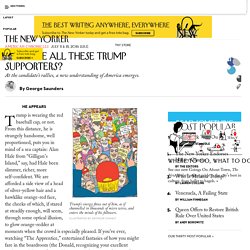
You're not going to believe what I'm about to tell you. Comics Blog Books Shop Comics: Random Most Popular All Cats Grammar Food Animals Tech.
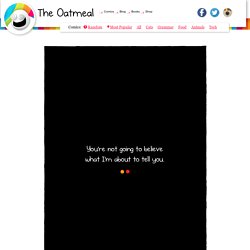
PREMS 162317 GBR 2018 Report désinformation. Introduction to Special Issue on Literacy, Democracy, and Fake News: Making it Right in the Era of Fast and Slow Literacies. Making media literacy great again. Illustration by Hanna Barczyk Professor Carl T.

Bergstrom began his first lecture for INFO198 at the University of Washington with a declaration about America. “There is so much bullshit,” he said, looking up at 160 students last spring. “We are drowning in it.” Bergstrom’s audience didn’t seem surprised or outraged by his phraseology. As Bergstrom spoke, a picture of Hillary Clinton and Donald Trump appeared on a screen behind him, followed moments later by a photo of a young woman typing on her phone. Stony Brook Center for News Literacy. By Richard Hornik Stony Brook University News Literacy, a curriculum developed at Stony Brook University in New York over the past eight years, is designed to help students develop the critical thinking skills needed to judge the reliability and credibility of information, whether it come via print, television or the Internet.

This is a particularly important life skill in the Digital Age, as everyone struggles to deal with information overload and the difficulty in determining the authenticity of reports. In the Stony Brook model, students are taught to evaluate information primarily by analyzing news as well as new forms of information that are often mistaken for journalism.
The Digital Age poses four serious information literacy challenges for civil society: Stony Brook Center for News Literacy. The full News Literacy course, developed at Stony Brook University, organizes the material into 8 concepts that are spread amongst our 14 week course that take students from the first information revolution of Johannes Gutenberg's printing press to the Digital Age of Mark Zuckerberg's Facebook.

Each lesson stands alone or can easily be integrated into your program. Below, find a summary of each of those lessons, and a link to the most updated version of the teaching materials for each from our professors at Stony Brook University. Each of the following Course Packs include PowerPoint presentations, associated media, lecture notes, and recitation materials. You will notice as the semester progresses, the name of some of our lessons change, along with the sequence of the lessons. If needed, you can find last semester's course pack at THIS LINK.
Teaching the Teachers: Training Opportunities. If you’d like to learn more about News Literacy and about how to teach it, here’s a range of options, from bite-sized bits to full meals and even full-length training courses.
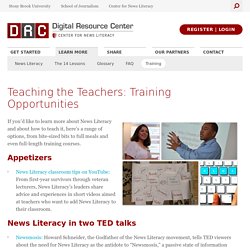
Appetizers News Literacy classroom tips on YouTube: From first-year survivors through veteran lecturers, News Literacy’s leaders share advice and experiences in short videos aimed at teachers who want to add News Literacy to their classroom. News Literacy in two TED talks Newsmosis: Howard Schneider, the Godfather of the News Literacy movement, tells TED viewers about the need for News Literacy as the antidote to “Newsmosis,” a passive state of information overload. "You don't want to hear it (and that's a problem worth working on)": Previous Center for News Literacy Director Dean Miller challenges TED viewers to fight the human tendency to block out facts that make us uncomfortable. The Psychology Of Fake News : 13.7: Cosmos And Culture. Nodar Chernishev/Getty Images/EyeEm Premium During the past two years, fake news has been a frequent topic of real news, with articles considering the role of social media in spreading fake news, the advent of fake videos and the role these play in the political process.

Something less well-known, though, is that fake news has also become a topic of scientific investigation. In a paper published in March in the journal Science, David Lazer, Matthew Baum and 14 co-authors consider what we do and don't know about the science of fake news. Google Has Picked an Answer for You—Too Bad It’s Often Wrong. The Future of Truth and Misinformation Online. Experts are evenly split on whether the coming decade will see a reduction in false and misleading narratives online.
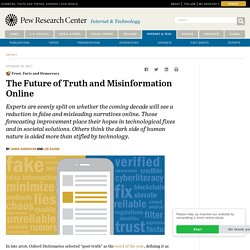
Those forecasting improvement place their hopes in technological fixes and in societal solutions. Others think the dark side of human nature is aided more than stifled by technology. In late 2016, Oxford Dictionaries selected “post-truth” as the word of the year, defining it as “relating to or denoting circumstances in which objective facts are less influential in shaping public opinion than appeals to emotion and personal belief.”
The 2016 Brexit vote in the United Kingdom and the tumultuous U.S. presidential election highlighted how the digital age has affected news and cultural narratives. This makes many vulnerable to accepting and acting on misinformation. Misinformation is not like a plumbing problem you fix. How did the news go ‘fake’? When the media went social. The Collins Dictionary word of the year for 2017 is, disappointingly, “fake news”.
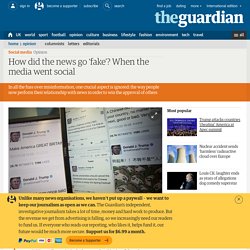
We say disappointingly, because the ubiquity of that phrase among journalists, academics and policymakers is partly why the debate around this issue is so simplistic. The phrase is grossly inadequate to explain the nature and scale of the problem. (Were those Russian ads displayed at the congressional hearings last week news, for example?) But what’s more troubling, and the reason that we simply cannot use the phrase any more, is that it is being used by politicians around the world as a weapon against the fourth estate and an excuse to censor free speech. Definitions matter. Oxford University Press Plagiarized Wikipedia, Now Who the Hell Should I Believe? The Covert World of People Trying to Edit Wikipedia for Pay. On January 11, 2013, James Heilman, an emergency-room physician and one of Wikipedia’s most prolific medical editors, was standing watch over the online encyclopedia’s entry for a back procedure called a kyphoplasty.

The page originally suggested that the procedure’s effectiveness was “controversial,” and an unidentified Wikipedia user had proposed changing the text to “well documented and studied”—a characterization that Heilman thought wasn’t supported by existing research. He rejected the change. Kyphoplasty, along with vertebroplasty, the procedure it shares a Wikipedia page with, is a common treatment when someone’s spine breaks—a frequent occurrence in people with osteoporosis, which makes bones brittle—and then doesn’t heal naturally. Macedonians Take Advantage of U.S. Post-Truth Politics to Make a Buck. The single most amazing story of the election was thrown up on the Intertoobz on Thursday by Buzzfeed News. It describes how the campaign of the Republican presidential nominee has re-energized the economy of Macedonia, and it is, well, just amazing. "Your Prayers Have Been Answered," declared the headline. For Trump supporters, that certainly seemed to be the case. They helped the baseless story generate over 140,000 shares, reactions, and comments on Facebook.
Meanwhile, roughly 6,000 miles away in a small Macedonian town, a young man watched as money began trickling into his Google AdSense account. Advertisement - Continue Reading Below It is nice to know that the United States remains a target-rich environment for the world's most enterprising gifters, because this Balkan cottage industry—which may be conducted in actual cottages, for all I know—has absolutely nothing to do with politics and absolutely everything to do with separating suckers from their money. The Internet's Dark Ages. The web, as it appears at any one moment, is a phantasmagoria. It’s not a place in any reliable sense of the word. It is not a repository. The high cost of not finding information. By Susan Feldman On Sept 23, 1999, NASA's Mars Climate Orbiter spacecraft disappeared. The spacecraft had flown nine-and-a-half months and 416 million miles flawlessly. Scientists were stumped at first about what had gone wrong.
» Newspapers and Thinking the Unthinkable Clay Shirky. Back in 1993, the Knight-Ridder newspaper chain began investigating piracy of Dave Barry’s popular column, which was published by the Miami Herald and syndicated widely. In the course of tracking down the sources of unlicensed distribution, they found many things, including the copying of his column to alt.fan.dave_barry on usenet; a 2000-person strong mailing list also reading pirated versions; and a teenager in the Midwest who was doing some of the copying himself, because he loved Barry’s work so much he wanted everybody to be able to read it. One of the people I was hanging around with online back then was Gordy Thompson, who managed internet services at the New York Times.
I remember Thompson saying something to the effect of “When a 14 year old kid can blow up your business in his spare time, not because he hates you but because he loves you, then you got a problem.” I think about that conversation a lot these days. Web usage data outline map of knowledge. How to choose your news - Damon Brown. How the media landscape has changed Media visionary Clay Shirky gave a TED Talk on how the media landscape has changed. “The moment we’re living through, the moment our historical generation is living through, is the largest increase in expressive capability in human history.” Professor Wikipedia. Essay on Wikipedia's fifteenth anniversary. Wikipedia came into the world 15 years ago today -- and, man, what an ugly baby.
The first snapshot of it in the Internet Archive is from late March of 2001, when Wikipedia was already 10 weeks old. Science magazine can’t defend its flawed business model. Facebook News Feed: Finally lets you choose which friends' posts to see first. Courtesy of Facebook The big complaint about Facebook* has always been that you can’t control what you see in your News Feed. The Eight-Second Attention Span. Infographic Shows Fair Use’s Importance in a Day in the Life of a College Student.
In conjunction with Fair Use/Fair Dealing Week 2016, ARL is releasing an infographic that shows how a college student relies on fair use numerous times in a typical day. Fair use and fair dealing are vitally important rights for everybody, everywhere—students, faculty, librarians, journalists, and all users of copyrighted material. These doctrines provide balance to the copyright system by allowing the use of copyrighted resources without permission from the rightholder under certain circumstances, thereby promoting creative progress and accommodating freedom of expression.
“Self-literacy” in the information age. Why plagiarize when you can rip off a writer's thoughts? Lines on Plagiarism Blur for Students in the Digital Age. “Now we have a whole generation of students who’ve grown up with information that just seems to be hanging out there in cyberspace and doesn’t seem to have an author,” said Teresa Fishman, director of the Center for Academic Integrity at Clemson University.
The_lawsuit_against_sci_hub_begs_the_question_why_are_academic_journals.